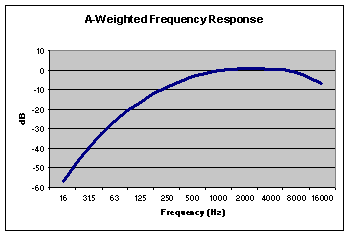The human ear responds more to frequencies between 500 Hz and 8 kHz and is less sensitive to very low-pitch or high-pitch noises. The frequency weightings used in sound level meters are often related to the response of the human ear, to ensure that the meter is measuring pretty much what you actually hear.
It is extremely important that sound level measurements are made using the correct frequency weighting - usually A-weighting. For example, measuring a tonal noise of around 31 Hz could result in a 40 dB error if using C-weighting instead of A-weighting.
The most common weighting that is used in noise measurement is A-Weighting. Like the human ear, this effectively cuts off the lower and higher frequencies that the average person cannot hear.
Defined in the sound level meter standards (IEC 60651, IEC 60804, IEC 61672, ANSI S1.4), a graph of the frequency response can be seen to the right.
A-weighted measurements are expressed as dBA or dB(A).

The response of the human ear varies with the sound level. At higher levels, 100 dB and above, the ear's response is flatter, as shown in the C-Weighted Response to the right.
Although the A-Weighted response is used for most applications, C-Weighting is also available on many sound level meters. C Weighting is usually used for Peak measurements and also in some entertainment noise measurement, where the transmission of bass noise can be a problem.
C-weighted measurements are expressed as dBC or dB(C).

Z-weighting is a flat frequency response of 10Hz to 20kHz ±1.5dB. This response replaces the older "Linear" or "Unweighted" responses as these did not define the frequency range over which the meter would be linear.
Z-weighted measurements are expressed as dBZ or dB(Z).